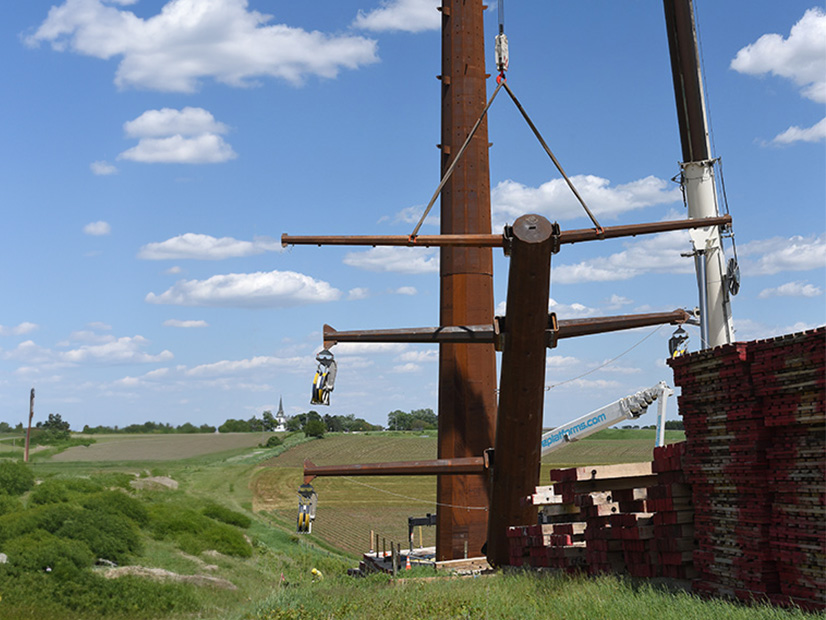WASHINGTON — Transmission policy has made progress lately, but ITC President Krista Tanner came to Capitol Hill to get one more item over the finish line: the permitting bill.
A bill cleared the Senate Energy and Natural Resources Committee with a bipartisan, 15-4, vote over the summer, and Tanner said she hopes it can become law. (See Manchin-Barrasso Permitting Bill Easily Clears Committee.)
“There’s widespread recognition that permitting reform is needed, and it’s coming from all corners,” Tanner said in an interview. “So, certainly, proponents of the IRA want to see this, because we’re not going to see the benefits of the IRA or achieve our climate goals if we don’t have the permitting. I mean, this is the last step that we need. Even if that’s not your perspective, we’re seeing energy demand growth in this country for the first time in 50 years. And so, we know that we need a resilient grid to connect new generation to serve new load.”
ITC Holdings is a transmission-only firm that owns most of the power grid in Michigan and Iowa and does business in five other states: Minnesota, Illinois, Missouri, Kansas and Oklahoma. While it can get through many of the more local projects in its service territories without issue, ITC’s joint Cardinal-Hickory Creek project with ATC and Dairyland Power Cooperative crossed the Mississippi River between Iowa and Wisconsin, cutting through a federal wildlife refuge in the process.
Nothing in the permitting bill passed by committee “guts” the National Environmental Policy Act and its requirements, but it would limit the amount of litigation involved in building transmission, Tanner said.
“On Cardinal-Hickory Creek, we had five different lawsuits, five different injunctions. We ultimately prevailed and found that we did, in fact, comply with NEPA and follow the appropriate process,” she added. “And so, it’s really the litigation and the injunctions that created a lot of delays on this project. And those delays aren’t inexpensive. Anytime we start and stop a project, that adds cost to the project.”
The line is poised to go into service as soon as this week, as the section crossing the river and the refuge has finally been built. The 102-mile line needed permits from Iowa, Wisconsin and several federal agencies that all had different processes, opening it up to multiple avenues for litigation.
While it did cross a refuge, ITC and the other backers tried to avoid affecting land in other areas, favoring existing rights of way. But it had to cross the Mississippi River at some point, and that section drew significant opposition. While the line did bring up land use issues, it will help connect significant amounts of clean energy to the grid.
“We have 160 renewable projects waiting to come online for this project, and they represent over 24 gigawatts of clean energy,” Tanner said. “We’re not going to achieve our clean energy goals if we don’t have the transmission to bring the clean energy onto the grid.”
One way to avoid such delays is to work with affected landowners and communities on the front end to address their concerns.
“Landowners and communities bear the burden of these lines on behalf of everyone, right?” Tanner said. “And so, it’s really important that you bring them in from the beginning. You talk to them about the need of the line, how it helps their community, not just the region, but their community.”
ITC will show communities what a proposed substation would look like and what facilities it would serve to indicate how it could provide local benefits. The firm works with landowners on where exactly transmission poles should be placed, and Tanner said it once even leased some other land for an affected landowner to hunt on because transmission line construction stopped them from using their own property.
FERC Order 1920 has a lot of commonsense transmission planning rules and is in line with what ITC has advocated for some time, Tanner said. MISO transmission practices also line up with the rules, which should solidify how things are done there, she added.
“I think it will quell the debate because, you know, cost allocation, all of these things remain contentious, and it seems like nothing is ever fully decided,” Tanner said. Having Order 1920 in place “just solidifies that this is the way we do planning in this RTO. We’re not going to keep revisiting these things.”
Some have argued that the forward planning MISO is engaged in, and FERC has backed in 1920, could lead to transmission overbuild. Tanner said she doubts that, especially based on what happened when MISO completed the Multi-Value Project lines.
“They were at capacity the minute they were built, because we thought too small,” Tanner said. “And so, I think we have to stop thinking small as a country and start betting on our economy and our manufacturers.”
While 1920 was an important step, FERC could add more “regulatory certainty” around returns on equity to help get transmission built, Tanner said. FERC has had an open proceeding in RM20-10 on incentives for several years and Commissioner Mark Christie has called for reforms in numerous dissents to orders approving them for specific projects.
Those unresolved ROE cases create uncertainty, Tanner said. “And given the need for investment, this is not the time to create uncertainty.”
Tanner also said she would like to see FERC further curtail competition in transmission planning and development. The system under Order 1000 has failed largely because independent developers lack the local knowledge of a firm like ITC, she said, which is transmission only but operates in specific communities.
“The only thing that Order 1000 has succeeded in is causing at least a year’s delay in projects, but it has not reduced the cost,” she added.



